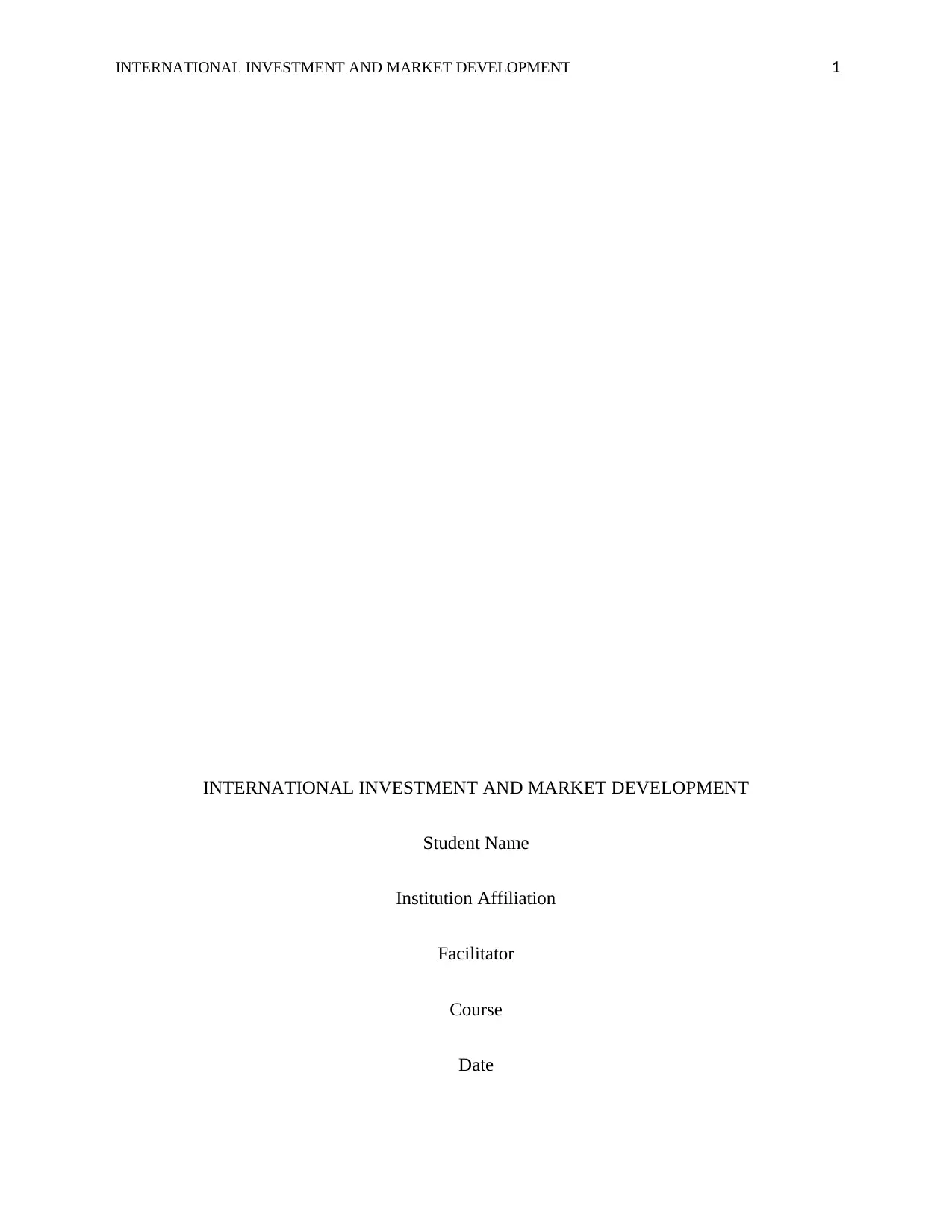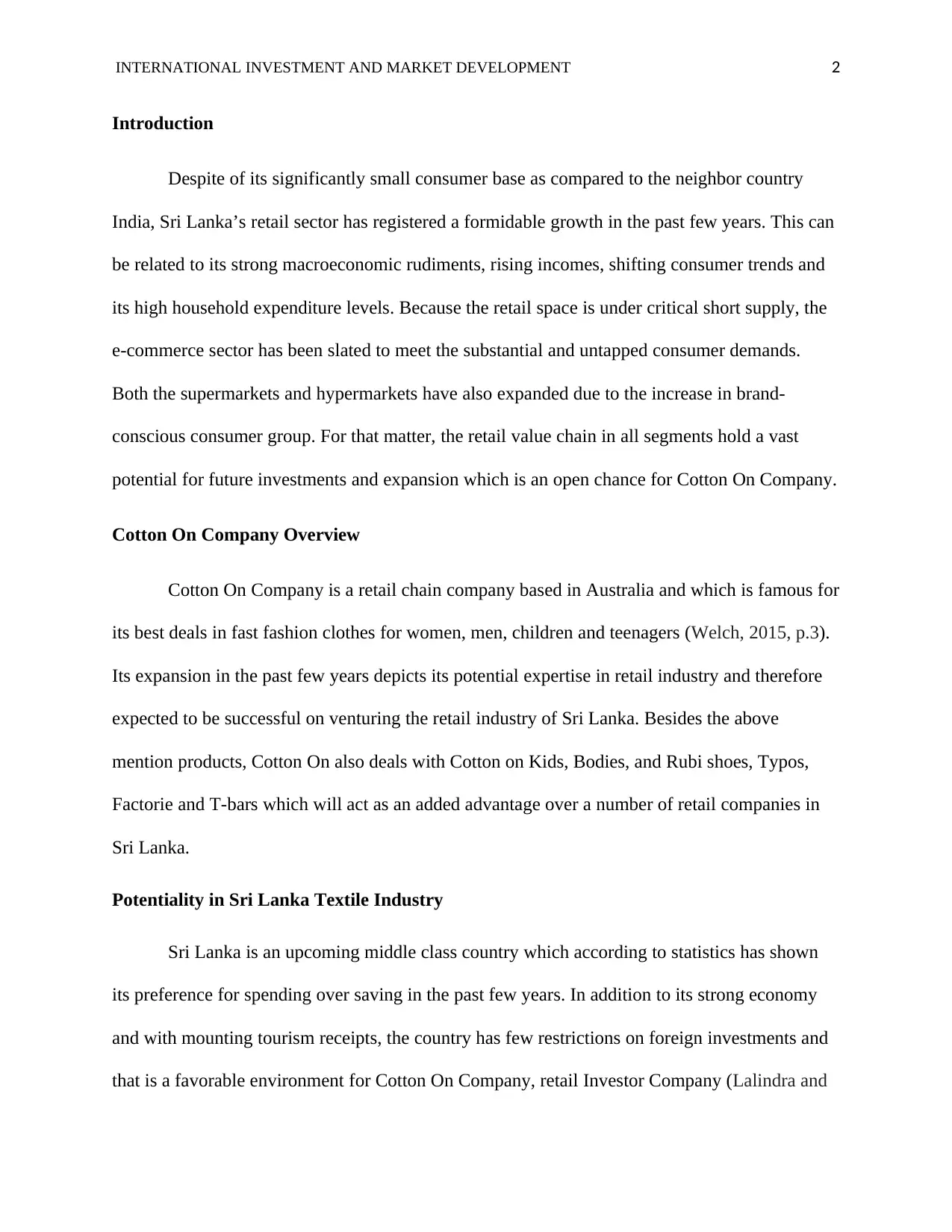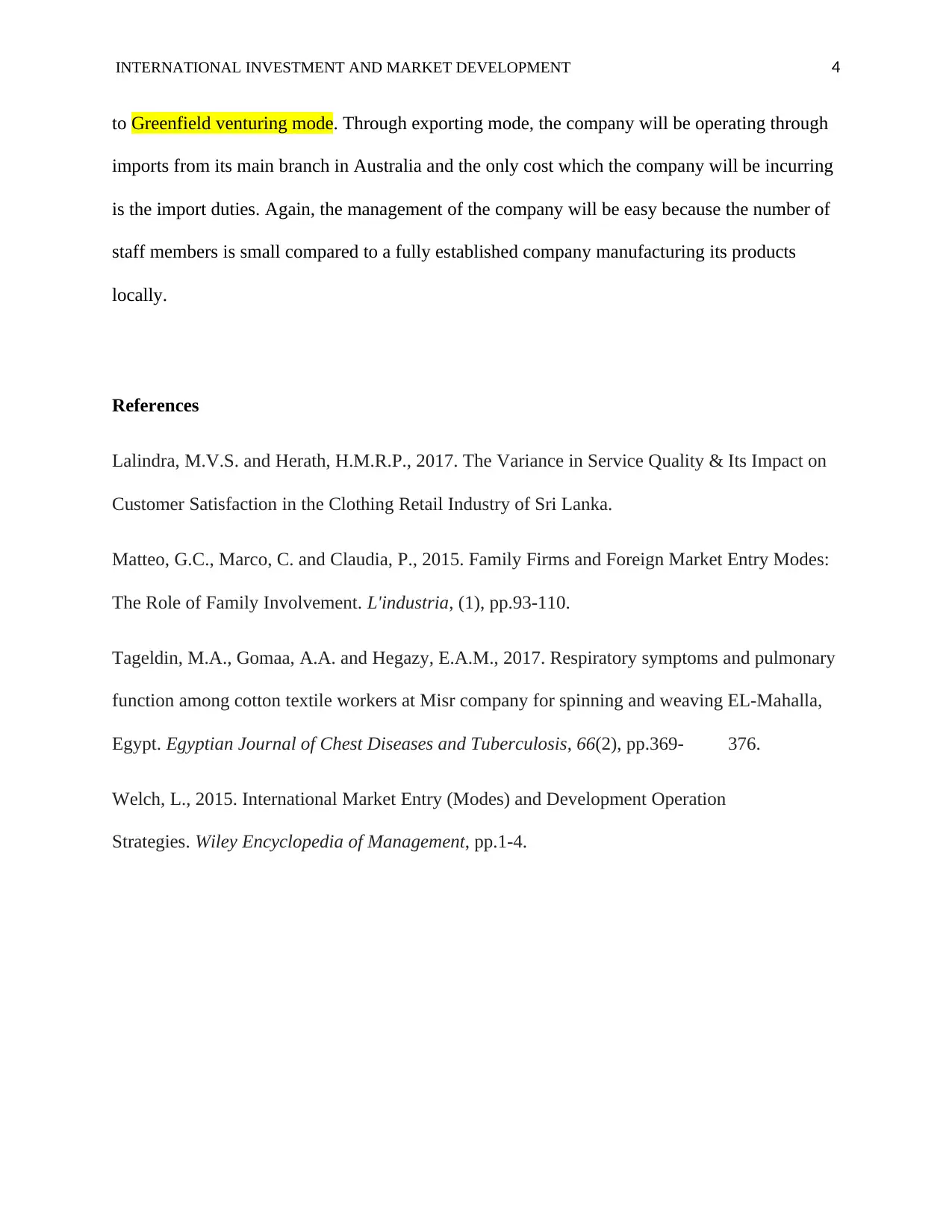International Investment & Market Entry: Cotton On in Sri Lanka
VerifiedAdded on 2023/06/07
|4
|925
|412
Report
AI Summary
This report analyzes Cotton On Company's potential for international investment and market development in Sri Lanka, highlighting the country's growing retail sector and favorable investment climate. Despite a smaller consumer base compared to India, Sri Lanka's strong macroeconomic fundamentals, rising incomes, and shifting consumer trends make it an attractive market. The report considers two market entry modes for Cotton On: Greenfield venturing and exporting, ultimately favoring the latter due to its lower cost and faster implementation. The analysis acknowledges near-term growth barriers such as limited retail space but suggests that Cotton On's established e-commerce platform can bridge this gap. By exporting finished products from Australia and leveraging its diverse product lines, Cotton On can capitalize on Sri Lanka's untapped consumer demands and achieve success in the retail industry.

INTERNATIONAL INVESTMENT AND MARKET DEVELOPMENT 1
INTERNATIONAL INVESTMENT AND MARKET DEVELOPMENT
Student Name
Institution Affiliation
Facilitator
Course
Date
INTERNATIONAL INVESTMENT AND MARKET DEVELOPMENT
Student Name
Institution Affiliation
Facilitator
Course
Date
Paraphrase This Document
Need a fresh take? Get an instant paraphrase of this document with our AI Paraphraser

INTERNATIONAL INVESTMENT AND MARKET DEVELOPMENT 2
Introduction
Despite of its significantly small consumer base as compared to the neighbor country
India, Sri Lanka’s retail sector has registered a formidable growth in the past few years. This can
be related to its strong macroeconomic rudiments, rising incomes, shifting consumer trends and
its high household expenditure levels. Because the retail space is under critical short supply, the
e-commerce sector has been slated to meet the substantial and untapped consumer demands.
Both the supermarkets and hypermarkets have also expanded due to the increase in brand-
conscious consumer group. For that matter, the retail value chain in all segments hold a vast
potential for future investments and expansion which is an open chance for Cotton On Company.
Cotton On Company Overview
Cotton On Company is a retail chain company based in Australia and which is famous for
its best deals in fast fashion clothes for women, men, children and teenagers (Welch, 2015, p.3).
Its expansion in the past few years depicts its potential expertise in retail industry and therefore
expected to be successful on venturing the retail industry of Sri Lanka. Besides the above
mention products, Cotton On also deals with Cotton on Kids, Bodies, and Rubi shoes, Typos,
Factorie and T-bars which will act as an added advantage over a number of retail companies in
Sri Lanka.
Potentiality in Sri Lanka Textile Industry
Sri Lanka is an upcoming middle class country which according to statistics has shown
its preference for spending over saving in the past few years. In addition to its strong economy
and with mounting tourism receipts, the country has few restrictions on foreign investments and
that is a favorable environment for Cotton On Company, retail Investor Company (Lalindra and
Introduction
Despite of its significantly small consumer base as compared to the neighbor country
India, Sri Lanka’s retail sector has registered a formidable growth in the past few years. This can
be related to its strong macroeconomic rudiments, rising incomes, shifting consumer trends and
its high household expenditure levels. Because the retail space is under critical short supply, the
e-commerce sector has been slated to meet the substantial and untapped consumer demands.
Both the supermarkets and hypermarkets have also expanded due to the increase in brand-
conscious consumer group. For that matter, the retail value chain in all segments hold a vast
potential for future investments and expansion which is an open chance for Cotton On Company.
Cotton On Company Overview
Cotton On Company is a retail chain company based in Australia and which is famous for
its best deals in fast fashion clothes for women, men, children and teenagers (Welch, 2015, p.3).
Its expansion in the past few years depicts its potential expertise in retail industry and therefore
expected to be successful on venturing the retail industry of Sri Lanka. Besides the above
mention products, Cotton On also deals with Cotton on Kids, Bodies, and Rubi shoes, Typos,
Factorie and T-bars which will act as an added advantage over a number of retail companies in
Sri Lanka.
Potentiality in Sri Lanka Textile Industry
Sri Lanka is an upcoming middle class country which according to statistics has shown
its preference for spending over saving in the past few years. In addition to its strong economy
and with mounting tourism receipts, the country has few restrictions on foreign investments and
that is a favorable environment for Cotton On Company, retail Investor Company (Lalindra and

INTERNATIONAL INVESTMENT AND MARKET DEVELOPMENT 3
Herath, 2017 ). Nevertheless, retail sector in this country is facing some near term barriers of
growth which include limited retail space. This trend therefore introduces a gap which can be
easily solved by Cotton On through its established e-commerce platform. The recent study by
Jones Lang LaSalle (JLL), a real estate consultancy firm has indicated that Asia Pacific’s cities
have been the most attractive destinations for retailers to and for that matter Cotton On can start
savvy investors, now is the time to start building the next Singapore or Hong Kong.
Market Entry Mode for Cotton On Company
Considering the fact that Cotton On is an already established company, it has two modes
of entry into Sri Lanka market: Greenfield venturing mode& Exporting mode. The cost of
entering Sri Lanka retail market in a Greenfield venturing mode is likely to be higher as
compared to exporting mode although preferred by many companies. For instance, if it chooses
Greenfield venturing mode, it will have to acquire land in Sri Lanka, establish its own buildings
and will still need to import some of the textile resources which are not locally accessible in the
country (Matteo, Marco and Claudia, 2015, p.96). This is beyond any reasonable doubt very
expensive compared to entering the market through exporting mode where it will only need to
rent its operational premises in the country and then can immediately start its operations by
exporting its finished products from its main branch in Australia.
Another disadvantage with entering the market through Greenfield venturing mode is that
it will take considerably a long period of time before it can start its operations. This is because it
will have to lay down procedures of operations including the acquisition of the relevant
operational documents from the local authorities which are not approved in a matter of days but
may take long periods of time (Tageldin, Gomaa and Hegazy, 2017, p.370). This makes it
feasible to enter the market through exporting mode as the documents required are less compared
Herath, 2017 ). Nevertheless, retail sector in this country is facing some near term barriers of
growth which include limited retail space. This trend therefore introduces a gap which can be
easily solved by Cotton On through its established e-commerce platform. The recent study by
Jones Lang LaSalle (JLL), a real estate consultancy firm has indicated that Asia Pacific’s cities
have been the most attractive destinations for retailers to and for that matter Cotton On can start
savvy investors, now is the time to start building the next Singapore or Hong Kong.
Market Entry Mode for Cotton On Company
Considering the fact that Cotton On is an already established company, it has two modes
of entry into Sri Lanka market: Greenfield venturing mode& Exporting mode. The cost of
entering Sri Lanka retail market in a Greenfield venturing mode is likely to be higher as
compared to exporting mode although preferred by many companies. For instance, if it chooses
Greenfield venturing mode, it will have to acquire land in Sri Lanka, establish its own buildings
and will still need to import some of the textile resources which are not locally accessible in the
country (Matteo, Marco and Claudia, 2015, p.96). This is beyond any reasonable doubt very
expensive compared to entering the market through exporting mode where it will only need to
rent its operational premises in the country and then can immediately start its operations by
exporting its finished products from its main branch in Australia.
Another disadvantage with entering the market through Greenfield venturing mode is that
it will take considerably a long period of time before it can start its operations. This is because it
will have to lay down procedures of operations including the acquisition of the relevant
operational documents from the local authorities which are not approved in a matter of days but
may take long periods of time (Tageldin, Gomaa and Hegazy, 2017, p.370). This makes it
feasible to enter the market through exporting mode as the documents required are less compared
⊘ This is a preview!⊘
Do you want full access?
Subscribe today to unlock all pages.

Trusted by 1+ million students worldwide

INTERNATIONAL INVESTMENT AND MARKET DEVELOPMENT 4
to Greenfield venturing mode. Through exporting mode, the company will be operating through
imports from its main branch in Australia and the only cost which the company will be incurring
is the import duties. Again, the management of the company will be easy because the number of
staff members is small compared to a fully established company manufacturing its products
locally.
References
Lalindra, M.V.S. and Herath, H.M.R.P., 2017. The Variance in Service Quality & Its Impact on
Customer Satisfaction in the Clothing Retail Industry of Sri Lanka.
Matteo, G.C., Marco, C. and Claudia, P., 2015. Family Firms and Foreign Market Entry Modes:
The Role of Family Involvement. L'industria, (1), pp.93-110.
Tageldin, M.A., Gomaa, A.A. and Hegazy, E.A.M., 2017. Respiratory symptoms and pulmonary
function among cotton textile workers at Misr company for spinning and weaving EL-Mahalla,
Egypt. Egyptian Journal of Chest Diseases and Tuberculosis, 66(2), pp.369- 376.
Welch, L., 2015. International Market Entry (Modes) and Development Operation
Strategies. Wiley Encyclopedia of Management, pp.1-4.
to Greenfield venturing mode. Through exporting mode, the company will be operating through
imports from its main branch in Australia and the only cost which the company will be incurring
is the import duties. Again, the management of the company will be easy because the number of
staff members is small compared to a fully established company manufacturing its products
locally.
References
Lalindra, M.V.S. and Herath, H.M.R.P., 2017. The Variance in Service Quality & Its Impact on
Customer Satisfaction in the Clothing Retail Industry of Sri Lanka.
Matteo, G.C., Marco, C. and Claudia, P., 2015. Family Firms and Foreign Market Entry Modes:
The Role of Family Involvement. L'industria, (1), pp.93-110.
Tageldin, M.A., Gomaa, A.A. and Hegazy, E.A.M., 2017. Respiratory symptoms and pulmonary
function among cotton textile workers at Misr company for spinning and weaving EL-Mahalla,
Egypt. Egyptian Journal of Chest Diseases and Tuberculosis, 66(2), pp.369- 376.
Welch, L., 2015. International Market Entry (Modes) and Development Operation
Strategies. Wiley Encyclopedia of Management, pp.1-4.
1 out of 4
Related Documents
Your All-in-One AI-Powered Toolkit for Academic Success.
+13062052269
info@desklib.com
Available 24*7 on WhatsApp / Email
![[object Object]](/_next/static/media/star-bottom.7253800d.svg)
Unlock your academic potential
Copyright © 2020–2026 A2Z Services. All Rights Reserved. Developed and managed by ZUCOL.





